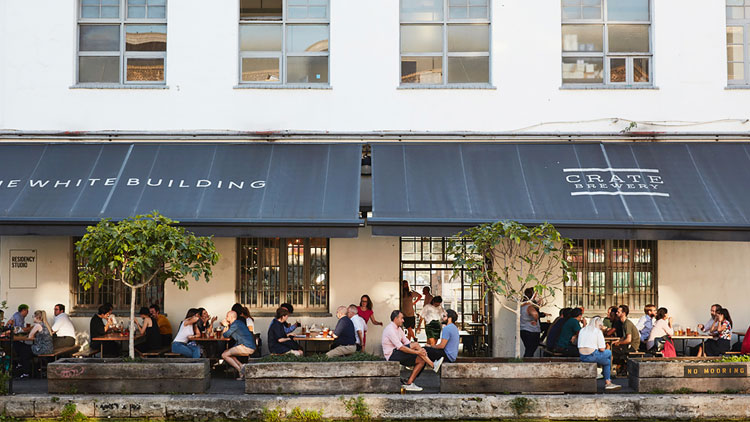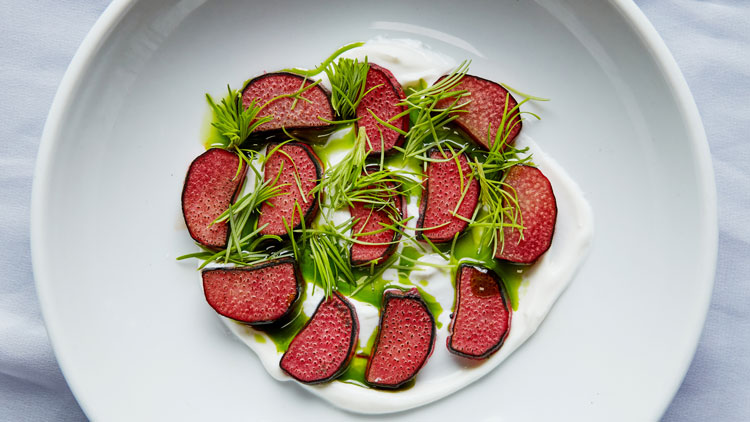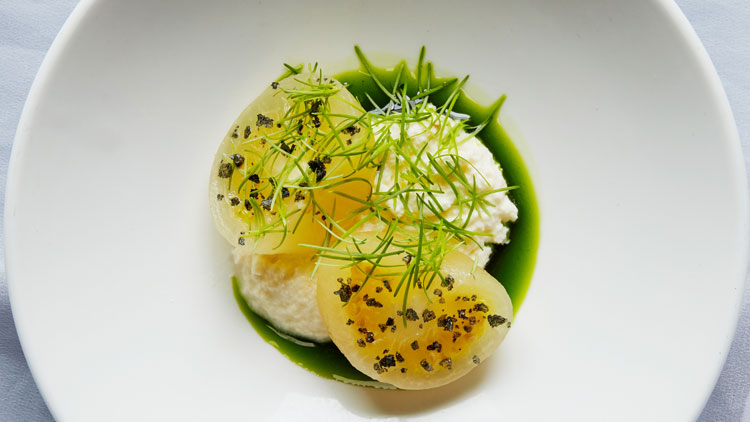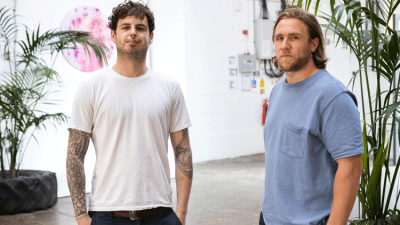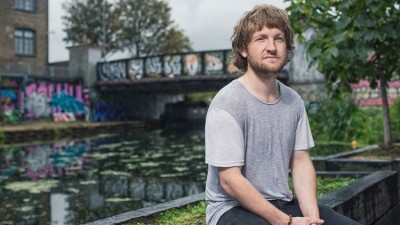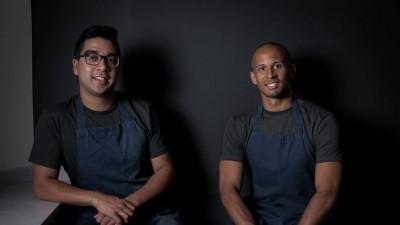Douglas McMaster: ‘I’m so ambitious to show the world that doing the right thing can be excellent’
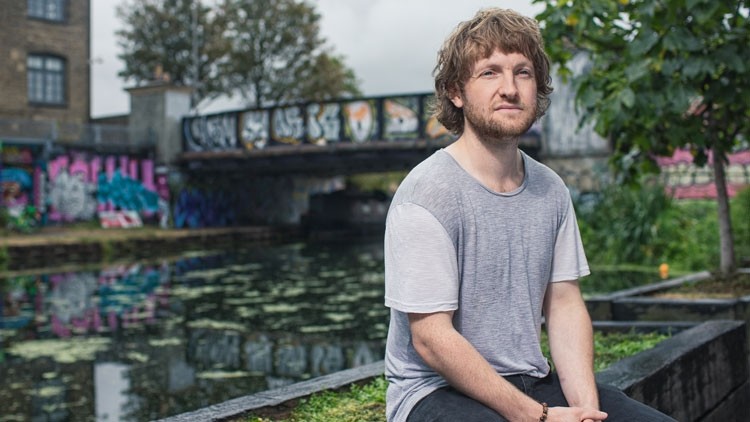
There will be no bin in Douglas McMaster’s new restaurant, Silo, when it opens in Hackney in November. This might appear a minor observation, but from this seemingly simple premise has grown the UK’s – if not the world’s – first zero-waste restaurant. Like its previous incarnation in Brighton, which closed earlier this year after half a decade to make way for the new project, nothing in Silo is thrown away.
And McMaster means nothing. Ingredients are delivered free of disposable packaging; food is cooked, served and eaten with any absolutely necessary leftovers turned into either green or brown compost; glass wine bottles are reduced to powder and turned into ‘porcelain’. In Silo’s ‘closed loop’ system there is no such thing as a by-product, just another product.
Those who know of McMaster, who is leading a one-man crusade against waste in restaurants, will be familiar with this approach. At Silo in Brighton, which he launched in 2014 and closed in June this year, McMaster has (in)famously strived to create and run a restaurant that tackles head on the thorny issue of the vast amount of waste generated in the world of hospitality. It was brave, uncompromising – diners were greeted with a large compost machine as a bold statement of intent – and by his own account incredibly difficult to do, often overwhelmingly so. In his book Silo, The Zero Waste Blueprint, there are numerous tales of chaos, of the restaurant nearly burning down, of McMaster sleeping on the restaurant floor and not leaving the premises for weeks on end. The pursuit of a zero-waste restaurant proved noble, but also chaotic and brutal.
From south coast to the Big Smoke
Almost exactly five years on from throwing open the doors to Silo Brighton and the 32-year-old chef from Sheffield sits outside Crate Brewery in Hackney in the drizzle on the cusp of opening Silo’s second coming. Later this month, Silo Hackney will open upstairs in The White Building following owner, Crate, having raised almost £1m in crowdfunding – double the original target – to not only improve its canal-side brewery and pizzeria but also open an entirely new project with the chef.
We are outside because McMaster says he’s more comfortable in the fresh air (he tries to have as many meetings as possible outside). Dressed in dark jeans and a grey t-shirt teamed with what look like brown suede Birkenstocks and with shaggy hair and a beard, he certainly has the look of an eco-warrior – he’s more Swampy than swanky – but he’s not the tub-thumping anarchist anyone reading his book might assume him to be. Affable, eloquent and instantly likeable, he admits he’s more comfortable when in conversation than having to speak about himself to a journalist, immediately asking his own questions before the interview begins. This isn’t the chef, whose restaurant manager once sent a group email about saying he needed psychological help for his almost maniacal approach to his project (as documented in the book), I was expecting.
This is because McMaster is now in a good place. If the five years at Brighton were at times punishing, they were also deeply formative and, after much trial, error and frustration the chef has now created a zero-waste system that is proven to work. What’s more, the impending move to London marks a new stage in Silo’s evolution where he can build significantly on what has gone before.
But why London and why now? With Brighton’s green credentials and its high vegan population, McMaster had found a captive audience in the eco-minded south coast dwellers. Brighton was the original first choice, so why the change now?
"I want people to walk into what they
think is one of the most beautiful dining rooms
in the world and then find out it is made of waste.”
There was not one major reason, it turns out, but rather that the timing was right. Brighton’s five-year lease had come to an end and McMaster says he had always intended to return to the capital, where he spent his formative years working at St John Bread and Wine.
“I love London, it is still my favourite city in the world. But in London it felt like we were trying to go through a locked door and then we could skip down and there would be an open door, that’s what Brighton was. It was a warehouse space, I could get produce from farms 20 miles away and Brighton had quirky people and a big vegan and organic movement. It was right at the time. But I knew I always wanted to come to London and I can’t open a second restaurant, I can only move it. You can’t yet commoditise what we do.”
There are other reasons for the move. In Brighton, McMaster says he reached a point where he stopped progressing, partly down to what he calls fundamental flaws in the business. “The space was designed badly by me. We’d reached a point where the supply chain couldn’t go any further. London is surrounded by a whole different dynamic of farmers and producers that we can work with to push the evolution forward.”
And then there’s the exposure. “I was looking at the history of Silo and what it might look like in 10 years to come. Imagine if we’d stayed in Brighton, how many people wouldn’t have come because it was in Brighton and how many people would come because it’s in London? London is a hub, and Brighton is just that bit further. Silo’s network is so much broader by being in London.”
That said, there’s no regrets, and he’s aware just how important starting out in Brighton was for Silo. He compares the early years to the agricultural idea of landacre, where a farmer sows 100 different varieties of seed in a field in a survival of the fittest test to discover the most suitable variety. In Silo’s case this meant testing hundreds of ideas, of which around only 10% worked, his appraisal of which is damning. “I made so many mistakes and in London standards are so high. If I’d opened in London and made those mistakes I would have failed.”
Yet here he is, with a restaurant in the capital only weeks away. Clearly things have changed. One key difference is the room itself, the utopian blank canvas that McMaster says all chefs crave. “To have a big rectangle room and design it from scratch rather than populate an existing building is the opportunity every chef would jump at. It has given us the opportunity to raise the standard of what we are doing considerably. The bigger investment from the crowdfund will also help,” says the chef, who re-mortgaged his parents’ house to raise £30,000 to launch Silo Brighton.
Making ethics more enticing
This is the crux of the matter. With Silo Brighton, McMaster was making a radical point that a restaurant that created absolutely no waste was not just a pipe dream. While it had many other qualities it was overtly ethical, in the same way that many vegetarian restaurants overtly don’t serve meat. Laudable? Yes. But sexy? No. And Silo Hackney can be sexy.
McMaster takes his cues from technology entrepreneur Elon Musk (albeit on a significantly smaller scale), of whom he is a fan. As head of Tesla, Musk injected life into the then worthy world of electric cars by launching supercharged,speed record-breaking cars that people wanted regardless of how green they were. In this spirit it is brilliance, not ethics, that is now a central focus of Silo.
For the interior, for example, he has worked with renowned interior designer Nina Woodcroft and material conservationist Seetal Solanki, “two of the UK’s best designers dealing in upcycling waste materials”, for an impressive dining room. “The plan is you don’t know you’re in a zero-waste restaurant. Silo Brighton had a compost machine, but my strategy has changed somewhat. I like people to know we compost food and upcycle glass, but we won’t force that down someone’s throat. I want people to walk into what they think is one of the most beautiful dining rooms in the world and then find out it is made of waste.”
The room will feature a central hearth and an open kitchen – “hearths are very popular in restaurants these days but Silo has this pre-industrial approach to food so it makes a lot of sense to be cooking with fire” – around which a counter will seat 18 people. The main dining area will have space for another 30 covers seated on round tables, which McMaster envisages will be used for larger groups.
Instead of printing paper menus, which wouldn’t fit with the no-waste model, the menu will be projected onto the restaurant’s 30ft wall (it will be powered by solar energy) with chairs positioned so it can be viewed comfortably. It will list around 10 dishes, but these are subject to change in real time, meaning the kitchen can alter the menu via a tablet mid service to reflect supply. If McMaster goes to a farm and it only has six white aubergines, he’ll take them and serve smaller portions, altering the menu when necessary.
Diners can order dishes separately or have a tasting menu with flex. “You could say you want the tasting menu but don’t like the sound of a particular dish and we can do a menu tailored to the table. It’s really agile and adaptable.”
Dishes will include smoked violet carrots with egg yolks and elephant garlic; and Jerusalem artichokes cooked on fire with stilton sauce and pickles, with Silo opening for brunch at the weekends to serve porridge with crème fraîche and seasonal fruit; coddled eggs, kimchi, black pudding; and freshly baked sourdough. “Nine times out of 10 the vegetables served will have been picked that day,” he says. “It sounds a cheffy thing to say but you really can taste
the difference.
“I might make mistakes but I’m so ambitious to show the world that doing the right thing can be excellent. I want people to have one of their favourite meals of their life and then realise there’s no bin, that staff work 45 hours a week, have a decent wage and I don’t shout at them. I want to prove to the world it can be done, that zero waste can be delicious, beautiful and profitable. This is the future.”
This last point would mark a progression because Brighton wasn’t really profitable, he admits. He wanted to buy a Tesla but couldn’t afford one. “I don’t see not being able to buy one as a failure. Give me five more years and I’ll have one.”
The drinks side of things has also been given close consideration. At his Cub restaurant in Shoreditch, McMaster paired up with best friend and drinks guru Ryan Chetiyawardana to explode the myth that cocktails can’t pair with food (“they’re seen as too strong, too much faff, too sweet, too expensive”) and at Silo the pair is taking this one stage further by serving cocktails as wine – they will have the same abv and be served in wine glasses.
“The benefits of a cocktail versus wine is that wine is limited to grape juice whereas cocktails can be any juice. It will be the same 125ml pour and the same price (£7 ish).” He’s keeping tight lipped on what these might be, but one example is a genmaicha tea from Henrietta Lovell’s Rare Tea Company infused into a base spirit.
Silo will also serve beer from Crate brewery as well as natural and biodynamic wines and Jarr kombucha, and will only stock spirits from Copenhagen-based Empirical Spirits, which he describes as having “dramatically changed what spirits look like”. Founded in 2017 by Noma alumni Lars Williams and Mark Emil Hermansen, the company doesn’t produce vodka, whisky or gin but rather its own spirit blends that are given names such as Helena, Bandit, Fallen Pony and even Fuck Trump and His Stupid Fucking Wall, a 27% abv spirit made from a base of pearled barley, Belgian saison yeast, koji and habanero vinegar. “We are taking pairing to a whole other level of special,”
he says.
Effortless sustainability
How McMaster believes he can achieve effortless sustainability, as he calls it, is all down to systems. When a chef joins the new Silo – he says Hackney has a waiting list of 40 chefs despite not even putting a post out for staff – they won’t face the challenges of the previous incarnation but will instead find themselves operating within a solid no-waste framework.
“They will walk into something that is simple. I’ve done the work and gone to the farms and sorted out deliveries. Chefs won’t have to dodge packaging because it won’t be there. In Brighton, I needed chefs to use their own intuition because I didn’t know what I was doing. Now I do and there’s a very clear and concise formula.”
He says he already knows every dish he’s going to serve within a percentage point or gram of each ingredient using specific formulas more akin to what you’d expect to find at The Fat Duck than in a Hackney warehouse. Every technique and formula is documented with each recipe equating to one portion, meaning it can be accurately scaled up depending on numbers of dishes required.
All veg scraps, for example, are boiled for four hours with a lid on, strained through a chinois and then reduced until they turn into a treacle-like syrup that tastes like hoisin sauce. “That will always happen because it will be used on every menu, it reduces food waste by half and creates this dynamite syrup that is brilliantly versatile. A chef comes into this kitchen and all the technical complex behaviour is a script. The chefs then work from this script.”
This doesn’t mean there is no day-to-day creativity, with these formulas providing a base in which ever-changing perishable ingredients are added “Tetris style”. Rather, it just guarantees a consistency that McMaster says wasn’t achievable in Brighton.
In fact, chefs at Silo need to know more than in an average kitchen. They are all trained to serve front of house, to be baristas and to make cocktails because the system relies on a brigade that is multi skilled. “In a traditional restaurant you wouldn’t need to know how to mill flour, culture cream or make yoghurt, but in Silo you do. I run my restaurant like a hive of bees, the hive moves together and works together, it’s a really unique environment.”
The vegan question
Even though McMaster is very eco minded, some might be surprised to find meat on his menus, which many would regard as going against such an ethos. He disagrees, arguing that while Silo serving meat has been a point of contention from day one there are ethical ways to serve meat, including invasive animals, retired breeding animals and those with no nervous system, such as oysters.
And while he welcomes the rise of veganism, he says the real issue shouldn’t be about not eating meat but avoiding the industrialisation of meat. “Veganism is essentially a reaction to a thing, which is poor animal welfare caused by industrialism. Animals are being killed in these horrible warehouses so the logic is ‘that’s terrible and that we shouldn’t eat animals’. If industrialism hadn’t dominated our food industry veganism would be a real minority. I don’t think it is the silver bullet to fix the problem. What needs to happen is humans and nature need to have a symbiotic relationship and veganism is not that. It’s still not a bad thing though.”
"Humans and nature need to have a
symbiotic relationship and veganism is not that"
This isn’t a rail against industrialism per se. McMaster is by no means blinkered against modern life: his arguments, all of which are concisely laid out in his book – a four-year labour of love – are erudite and enlightening. “Industrialism isn’t bad, it’s done a lot of great things, but it’s the thinking it’s the tool for everything,” he continues. “With food it doesn’t make sense to eat processed dead food, it’s very short sighted.”
Instead, he favours an agrarian society in which small areas feed their community with perishable food before looking further afield for “luxuries” such as coffee and chocolate. “Because of this scale there’s a more intimate relationship with where food comes from, who produces it and how it’s produced. When you have that you’re less likely to waste it and more likely to enjoy it and make it a precious thing. If we had an agrarian scale food economy, we would be so much healthier and happier and there would be a lot less waste.”
Thoughts for the future
If Silo Brighton proved that a no-waste restaurant was possible, and Silo Hackney is vying to show that it can even rival London’s best restaurants, what’s McMaster’s next move? He concludes his book by calling people who believe industrialism to be the only way to feed the world “muppets”, a bold statement that suggests one zero-waste restaurant won’t satisfy his world-changing view.
In the short term, however, it will, he says. “My 10-year plan isn’t to branch out and spread myself thin. I need to make sure Silo is the best version of itself and put a flag deep into the ground to represent the first zero-waste restaurant.”
McMaster says he hopes that in five years’ time a dozen or so other zero-waste restaurants might open, maybe dealing with other things, such as a zero-waste build or looking at water waste, and that it can be applied to different cuisines. After all, as he says: “It’s just a back-end system change.”
But, true to form, he does have one eye on the bigger picture, saying he also has the answer for a zero-waste domestic food system that piggybacks on existing things such as bulk stores and food delivery that relies on reusable packaging, electric vehicles and automatically populating Google calendars for better ingredient management.
“The system would work, 100%,” he insists. “But there aren’t enough hours in the day to work it out.”
Well, not yet, anyway.
